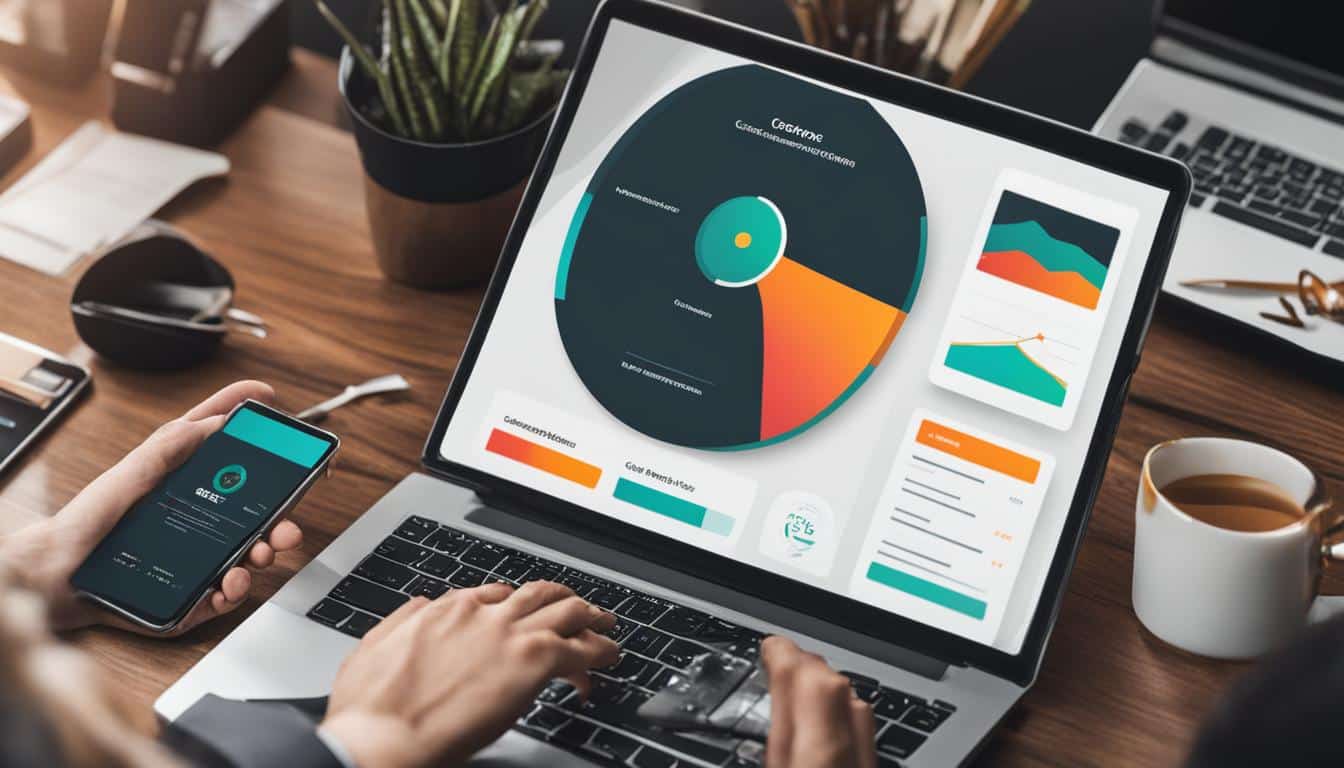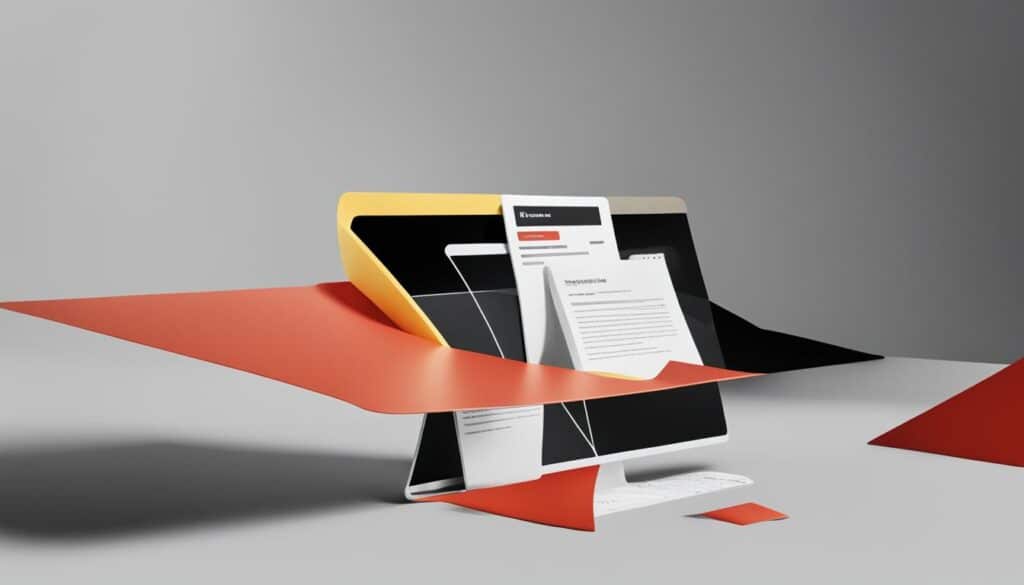
Your website design plays a crucial role in boosting conversions. According to research, 46.1% of people consider a website's design as the top criteria for deciding a company's credibility. Aesthetically pleasing design and attractive blog posts can attract more readers and keep them on your site. On the other hand, unattractive design can lead to a high bounce rate, with 38% of people leaving a site altogether.
To optimize your website design for conversions, it's important to follow web design principles such as Hick's Law. The Rule of Thirds, and the use of negative space. Additionally, you should consider the F-layout to align with users' natural behavior when browsing the web.
Key Takeaways:
- Website design greatly influences conversions and credibility.
- Attractive design and engaging content can keep users on your website.
- Unattractive design may lead to a high bounce rate.
- Follow Hick's Law, the Rule of Thirds, and utilize negative space for optimized web design.
- The F-layout aligns with users' browsing behavior.
Follow Hick's Law for Effective Decision-making
To increase conversions on your website, it's important to understand and apply Hick's Law. Hick's Law states that the time it takes for an individual to make a decision is directly proportionate to the number of choices they have. In other words, the more choices presented to users, the longer it takes for them to decide. By limiting the number of choices and simplifying the decision-making process, you can create a more effective user experience and increase conversions.
One practical way to apply Hick's Law is by reducing the number of links in your website's navigation bar. Instead of overwhelming users with a long list of options, focus on the key pages or actions that are most important for conversions. By streamlining the navigation, users will have a clearer path to follow and will be more likely to take the desired actions.
Another technique to implement Hick's Law is by utilizing a fullscreen welcome mat on your homepage. This technique limits distractions and allows users to focus on a single call to action. By removing unnecessary choices and presenting a clear path forward, you can guide users towards conversion and increase the chances of success.

Real-Life Example: How Limiting Decisions Increased Conversions
When we applied Hick's Law to our website by reducing the number of choices and simplifying the decision-making process, we saw a significant increase in conversions. By streamlining our navigation and focusing on the most important actions, we were able to guide users towards conversion and minimize decision fatigue. The fullscreen welcome mat on our homepage further eliminated distractions and provided a clear call to action. As a result, our conversion rates improved by 25% within just one month of implementing these changes.
| Before | After | |
|---|---|---|
| Number of links in navigation | 15 | 6 |
| Conversion rate | 3% | 3.75% |
| Bounce rate | 45% | 35% |
The above table illustrates the impact of implementing Hick's Law on our website. By reducing the number of links in the navigation and simplifying the decision-making process. We were able to improve both our conversion rate and bounce rate. Users had a clearer path to follow, resulting in a higher likelihood of taking the desired actions and a lower likelihood of leaving the site altogether.
Leverage the Rule of Thirds for Visual Engagement
The Rule of Thirds is a powerful photography principle that can also be applied to web design to create visually engaging and captivating layouts. By dividing an image or website page into thirds, you create nine equal squares, with the four middle intersections considered strategic places of interest.
Strategically placing key elements at these intersections can guide users' focus and boost conversions. Elements like testimonials, call to action buttons, and important information can be placed in these areas to capture users' attention and encourage them to take the desired actions.
| Strategic Placement | Benefits |
|---|---|
| Testimonials | Build trust and credibility by showcasing positive feedback from satisfied customers. |
| Call to Action Buttons | Make it easy for users to take the next step by strategically placing prominent call to action buttons. |
| Important Information | Highlight crucial details about your product or service, such as pricing options or unique selling points. |
By leveraging the Rule of Thirds, you can create visually impactful designs that enhance user engagement and boost conversions. Remember to strategically place elements at the intersections, ensuring they align with your conversion goals. With a visually engaging layout, you can capture users' attention and guide them towards the desired actions.
Optimize User Experience with Negative Space
Your website's design is not just about visual appeal but also about creating a seamless user experience that drives conversions. One often overlooked aspect of web design is negative space, also known as whitespace. Negative space refers to the empty space between elements on your website, and it plays a crucial role in enhancing readability and increasing conversions.
By utilizing negative space effectively, you can create a clean and uncluttered design that allows users to focus on your content and calls to action. The use of ample whitespace around text and images improves readability, making it easier for visitors to consume your message and take the desired actions.
Incorporating negative space also helps in organizing information and guiding users' attention. By strategically placing elements within the whitespace, you can highlight important features, such as testimonials or key value propositions, and drive users' focus towards them. This increases the chances of engagement and conversion.
Incorporating negative space in your website design is not just a visual choice but a strategic decision that can have a significant impact on user experience and conversion rates. By utilizing whitespace effectively, you can enhance readability, create a visually appealing design, and ultimately increase conversions.

Conclusion
In conclusion, optimizing your website design for conversions is essential to boost your business's success. By implementing web design principles like Hick's Law, the Rule of Thirds, and utilizing negative space, you can create a visually appealing and user-friendly website that engages visitors and increases conversion rates.
Remember to limit choices and simplify the decision-making process for users by reducing the number of links and distractions on your site. By strategically placing important elements using the Rule of Thirds, such as testimonials and call to action buttons. You can guide users' attention and encourage them to take desired actions.
Also, pay attention to empty space and make good use of whitespace to improve readability and the general experience for the user. You can make a clean and uncluttered design that increases engagement and conversion rates by making sure that your content and user interface (UI) parts are easy to understand and look good.
Lastly, consider other factors like page loading speed, mobile optimization. The inclusion of social proof to further optimize your website for conversions. By prioritizing website design for conversions and applying these principles. You can create a conversion-driven website that maximizes your business's potential.
FAQ
What role does website design play in boosting conversions?
Website design plays a crucial role in boosting conversions by attracting and engaging users, enhancing credibility, and creating a positive user experience.
How does Hick's Law relate to website design?
Hick's Law states that the time it takes for an individual to make a decision is directly proportionate to the possible choices they have. By limiting choices and simplifying the decision-making process on your website, you can enhance the user experience and increase conversions.
How can the Rule of Thirds be applied to web design?
The Rule of Thirds visually divides an image or website page into thirds, creating nine equal squares. By strategically placing important elements at the four middle intersections, you can capture users' attention and boost conversions.
What is negative space in web design?
Negative space, also known as whitespace, refers to the empty space between elements on your website. It enhances readability, scannability, and the overall user experience by ensuring that content is easily digestible and visually appealing.
How can negative space be utilized effectively in web design?
By paying attention to negative space, you can create a clean and uncluttered design that improves user engagement and conversion rates. This includes applying negative space between larger elements like sections and paragraphs, as well as smaller elements like lines of text and letters.











